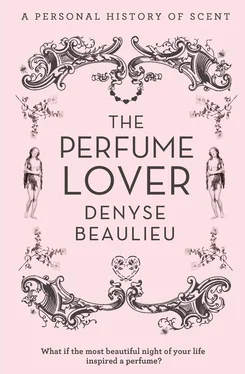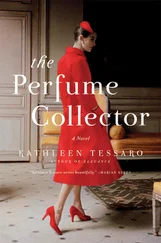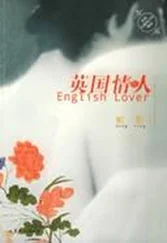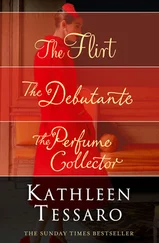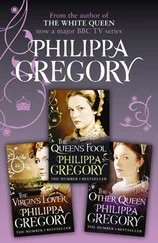Sweat was rolling between my breasts. My stalker was still there, some guy idling away his lunch hour, probably enjoying my panic, his hunter’s instincts aroused. I ducked into a perfume shop – the touristic Avenue de l’Opéra hadn’t been hit by the annual holiday shut-down. A slight, dark woman with side-swept hair framing a heart-shaped face, her crimson lips a vivid contrast with the lapis lazuli of her drawstring-waist dress, gave me what I would later come to call ‘the Parisian bar-code gaze’: a jaded, swift, head-to-toe assessment of market value. She made me feel as though I’d crawled out of a trashcan.
‘May I help you, mademoiselle?’
I peered through the window. My stalker was leaning down to spy on me between the Christian Dior displays.
‘Actually, I came in because this man was following me … No, don’t look! Can I stay here for a while?’
I was beginning to amuse her. Slightly.
‘Stay as long as you want.’
I fussed with the lipsticks, jabbering about annoying Parisian men. Lapis Lazuli cocked her head on her shoulder.
‘And why does that bother you?’
‘I find it … insulting. As though they thought I was cheap.’
‘They’re just trying their luck. No harm done. Let me know if I can help you with anything.’
I turned my attention to the bottle display. Since Tigress, I’d managed to smuggle Shalimar talcum powder and a Coty Sweet Earth compact with three small pans of wax smelling of hyacinth, honeysuckle and ylang-ylang into the house. The latter’s scent stayed fairly close to the skin and I’d found I could risk it even in the vicinity of my father’s oversensitive nose. But the stuff on those shelves was better: a dive into the glossy pages of French magazines.
‘That’s a very pretty dress you’ve got there, mademoiselle. Did you find it at the flea market in Saint-Ouen?’
I’d been to Saint-Ouen, of course, though the dress came from a vintage clothing stall in downtown Montreal. Since I’d stumbled on it, my closet had become crowded with what my mother disgustedly called ‘old clothes’ – 40s crepe dresses, ruched silk blouses and nip-waisted, shoulder-padded satin jackets. Clearly, I was on to something if this elegant Parisian thought my dress was pretty …
I reached out my hand to a bottle shaped like a flattened drop, took off the cap and was on the verge of raising it to my nose when Lapis Lazuli snatched it, deftly dipped a blotter into it and waved it around in the air before handing it over.
‘Voilà, that’s how it’s done,’ she said in that dry, pedagogical voice Parisian women use when they’re handling clueless tourists. Her bronze-lacquered eyelids fluttered as she brushed me with another bar-code look, a little more slowly this time.
‘You’re lovely … so pulpeuse.’
It was the first time I’d heard that particular French word, a synonym for plump, perhaps, but one conjuring ripe-fleshed fruit rather than blubber. Lapis Lazuli had pronounced it as though she’d kissed the air twice. I wondered whether she was coming on to me. In fact, she was closing in for the kill.
‘You need a luscious, ample, floral scent to suit those naughty eyes of yours peeping under your fringe – no wonder men are following you around … This is First, by Van Cleef and Arpels. I’ve always thought jasmine was wonderful with pale olive skin like yours …’
Pearly bubbles popped inside my nose while I flailed about for my scant olfactory references.
‘This reminds me a little bit of … Rive Gauche, maybe?’
Lapis Lazuli nodded.
‘It’s in the same family, but it’s more opulent. It may be too ladylike for you though. How about Azzaro? It’s also got jasmine, and rose, and gardenia, but with a warm amber and sandalwood base. The little touch of plum gives it a lovely rounded feeling …’
I’d never heard anyone speak about fragrance that way. Apart from my dissections of ads with Sylvie to pick out the women we’d become if we sprayed on the potions, I’d never discussed fragrance at all. Of all the notes Lapis Lazuli had mentioned, only rose and plum came within the scope of my experience. But Azzaro did feel like a better fit than First. There was something tender about it, an earthiness seeping through the flowers.
I wandered over to a round bottle with a cap in the shape of twin stylized arums. This brand I knew better. In a bid to wean me off my ‘smelly old rags’ my mother had sewn me a flowered chiffon drop-waist dress by Chloé from a Vogue Paris Original pattern and I loved the way the drawstring neck slid off my shoulder when I loosened it after leaving the house.
‘Why yes! Chloé. Why didn’t I think of it myself?’
Smothered in an avalanche of white petals, I gasped, inhaled again, and let out a little delighted chuckle. This I could understand: FLOWERS.
‘I’ll take it!’
Lapis Lazuli tut-tutted.
‘You need to know if it likes your skin and if your skin likes it. Try it on for a while.’
What, she didn’t want to make the sale now?
‘Try Chloé on one wrist and Azzaro on the other. You can come back later.’
I did come back the next day for a bottle of Chloé. Not because I was particularly smitten with it: for all her frothy blondeness and floaty flowered chiffon, Karl Lagerfeld’s first fragrance felt like she could pogo me off the dancefloor without breaking a stiletto heel. But it would have been hard to find a scent more obnoxious to my father; the olfactory equivalent of the Dior scarlet lipstick I also bought from Lapis Lazuli when I went back.
Needless to say, that huge wake of flowers drew even more Parisian flesh-hounds. Some of Lapis Lazuli’s sexual self-confidence must have seeped under my skin, because I was starting to feel it was fun. I’d even dawdle and throw backwards glances from under my fringe. My body may not have had a Vogue model’s tawny long-limbed elegance or Lapis Lazuli’s dusky wiriness, but it had magnetic power. Men were such animals …
My Parisian initiation came at a turning point for the industry. The 1976 First by Van Cleef and Arpels was actually ‘the last major perfume of this century which was developed in the classical manner, the last perfume not to use marketing’, its author Jean-Claude Ellena told Michael Edwards in Perfume Legends. Later on, in his Journal of a Perfumer, he added that he had ‘collected, borrowed and piled up every sign of femininity, wealth, power’ to compose it.
The following year, a perfume was launched that outdated the bourgeois charms of the Van Cleef and sent perfume executives scurrying to huddle with their marketing teams; a perfume that tapped directly into the subconscious perception of perfume as a mysterious, intoxicating substance that could magically transform women into exotic empresses.
Yves Saint Laurent’s 1977 offering sprung, as fragrances had since Poiret’s day, from the sovereign decision of a couturier. What was unprecedented was the strength and consistency of its scandalous concept.
Opium wasn’t the first perfume to be named after a drug. The 1933 Cocaina en Flor, by the Spanish house of Parera, was promoted as ‘a mysterious perfume … which enthrals, attracts, bewitches’. Further back, the industrial-strength 1927 Russian perfume Krasnyi Mak, ‘Red Poppy’, overtly played on balsamic, spicy notes evocative of opium resin, a product of Soviet Afghanistan. Did the same concept inspire similar olfactory results? ‘Red Poppy’ smells like a forerunner to Opium. But the drug that Yves Saint Laurent was thinking of in his blissed-out Marrakech retreat was LSD, according to the designer Pierre Dinand, who went to meet the couturier in his Villa Majorelle to discuss the bottle. The name Opium sprung from the Japanese inro Dinand brought as an inspiration in a later session. Yves Saint Laurent recognized it instantly as the phial samurais used to carry their salt, spices and … ‘opium!’ he exclaimed. The American pharmaceutical company that owned the licence for Yves Saint Laurent perfumes, Squibb-Myer, was understandably horrified, but Saint Laurent was adamant – and right. The scandalous, exotic, mysterious Opium was appropriated by women all over the world precisely because, like the drug, it promised escape. The perfume itself was of unheard-of strength and concentration for a French fragrance. Up to then, only Estée Lauder had offered such powerful brews and, in fact, the American grand dame was distinctly displeased at recognizing a formula quite similar to her own Youth Dew (she retaliated with Cinnabar, in what would be dubbed ‘the war of the tassels’). Industry insiders also say Opium was actually quite cheap to make, which would induce a downward spiral in budgets.
Читать дальше
